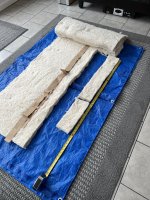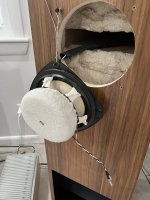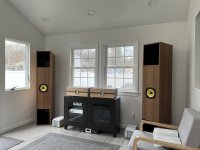Not as far as I can see. That's a pretty good in-room response measurement for a pair of back-horns given the speaker & microphone locations & the room size / furnishings / apparent construction. Welcome to the reality of in-room low frequency response. 😉
I've used the FE206ES-R drivers in a pair of Sachikos for more than a decade. Used with a Korneff 45 amplifier they've astounded many a jaded audiophile. I've used them with Dave's phase plugs (huge improvement) and I also put a handful of acousta-stuff in the tunnel behind the "compression chamber" behind the driver. I also put felt on the walls of the chamber behind the driver, on the bottom and on the outside walls (leaving the inside wall and top bare).
@BHD
I had arranged to acquire a pair of 206 ES-R that were supposed to be NOS.
Unfortunately, when they arrived and I opened them up I discovered that some moisture had gotten to them and caused mildew and mold to form on the cones. Didn’t want to deal with another driver project.
I’m going to be working on the back chambers with cotton felt and batting I purchased when I move forward with the modified 206e swap.
I’m wondering what the best way to attach the felt/batting is…since the cabinets are already assembled.
Dealing with contact/rubber cement seems like it will be a drag.
Not sure I can get a stapler in there and maneuver it as needed.
I had arranged to acquire a pair of 206 ES-R that were supposed to be NOS.
Unfortunately, when they arrived and I opened them up I discovered that some moisture had gotten to them and caused mildew and mold to form on the cones. Didn’t want to deal with another driver project.
I’m going to be working on the back chambers with cotton felt and batting I purchased when I move forward with the modified 206e swap.
I’m wondering what the best way to attach the felt/batting is…since the cabinets are already assembled.
Dealing with contact/rubber cement seems like it will be a drag.
Not sure I can get a stapler in there and maneuver it as needed.
No comments on the discrepancies in the T/S parameters I measured with DATS on the modified 206e?
Was hoping maybe Dave would comment…I figured he may have measured quite a few fullrangers.
In contemplating the in room response measurement I did a search to refresh my limited understanding and randomly came across this post in the AVS forum:
“In 1896 Rayleigh showed that the air enclosed in a room has an infinite number of normal modes of vibration. These are referred to as room modes or standing waves. The frequencies at which these modes occur are given by the following:
f = c/2 (sqRt (p/L)2 + (q/W)2 + (r/H)2)
where:
c is the speed of sound
L is the length of the room
W is the width of the room
H is the height of the room
And p, q, and r are the integers 0, 1, 2, 3.
As we can see from the formula, speaker placement has no bearing on the matter. The standing wave condition is set up only when the air particle velocity at the boundary is zero. Whenever air particle velocity is zero, pressure is at the maximum level. (If the walls are not perfect reflectors, losses at the walls will affect the heights of the maxima and depths of the minima.)
All room modes are represented as a sinusoidal wave form and for any given modal frequency the peak is always located at the room boundary. Thus, the location of any null or peak will be a function of the boundary and frequency and not a function of speaker placement. Since the condition for a standing wave is that particle velocity must be zero at each opposite reflecting surface, the peak of the wave must occur at the wall surface, and, hence, standing waves can only occur where the distance between the boundaries are an exact multiple of the wave length. By extension, then nulls are a function of only the distance between the boundaries and the frequency (wave length). While speaker placement will not affect the location of peaks and nulls, it will affect the maxima and minima of the effect.
In the same manner, you cannot have an asymetrical standing wave form. For example, in an 18' room, you cannot have a null at 6' without also a null at 12'. Moving the speaker from the front to the back of the room will simply alter the location of the speaker, not the location of peaks and nulls. Moving the speaker out away from the boundaries, by various distances, will also not affect the existence, or location of, nulls and peaks ... it will affect the maxima and minma of certain (not all) modes.”
So it seems if this is accurate, I am stuck with the nulls I have and can only hope to help minimize them with placement and/or additional room treatments.
Only other thing we considered doing in this room was possibly hanging some sheer curtains on the windows.
It’s a sunroom…we like all the light it lets in. Not sure a sheer curtain would make any difference.
I am also curious what would happen if I chose to add a subwoofer (or two) in a different location in the room.
Was hoping maybe Dave would comment…I figured he may have measured quite a few fullrangers.
In contemplating the in room response measurement I did a search to refresh my limited understanding and randomly came across this post in the AVS forum:
“In 1896 Rayleigh showed that the air enclosed in a room has an infinite number of normal modes of vibration. These are referred to as room modes or standing waves. The frequencies at which these modes occur are given by the following:
f = c/2 (sqRt (p/L)2 + (q/W)2 + (r/H)2)
where:
c is the speed of sound
L is the length of the room
W is the width of the room
H is the height of the room
And p, q, and r are the integers 0, 1, 2, 3.
As we can see from the formula, speaker placement has no bearing on the matter. The standing wave condition is set up only when the air particle velocity at the boundary is zero. Whenever air particle velocity is zero, pressure is at the maximum level. (If the walls are not perfect reflectors, losses at the walls will affect the heights of the maxima and depths of the minima.)
All room modes are represented as a sinusoidal wave form and for any given modal frequency the peak is always located at the room boundary. Thus, the location of any null or peak will be a function of the boundary and frequency and not a function of speaker placement. Since the condition for a standing wave is that particle velocity must be zero at each opposite reflecting surface, the peak of the wave must occur at the wall surface, and, hence, standing waves can only occur where the distance between the boundaries are an exact multiple of the wave length. By extension, then nulls are a function of only the distance between the boundaries and the frequency (wave length). While speaker placement will not affect the location of peaks and nulls, it will affect the maxima and minima of the effect.
In the same manner, you cannot have an asymetrical standing wave form. For example, in an 18' room, you cannot have a null at 6' without also a null at 12'. Moving the speaker from the front to the back of the room will simply alter the location of the speaker, not the location of peaks and nulls. Moving the speaker out away from the boundaries, by various distances, will also not affect the existence, or location of, nulls and peaks ... it will affect the maxima and minma of certain (not all) modes.”
So it seems if this is accurate, I am stuck with the nulls I have and can only hope to help minimize them with placement and/or additional room treatments.
Only other thing we considered doing in this room was possibly hanging some sheer curtains on the windows.
It’s a sunroom…we like all the light it lets in. Not sure a sheer curtain would make any difference.
I am also curious what would happen if I chose to add a subwoofer (or two) in a different location in the room.
measured with DATS
I pay littke attention, it is really only good for driver matching. What post did you put it in?
dave
Not well matched. but the most important spec, the sensitivity is MIA.
The horn will dominate the bass (ie basic T/S), sensitivy will affect imaging.
dave
The horn will dominate the bass (ie basic T/S), sensitivy will affect imaging.
dave
I thought the sensitivity was the “SPL” field that DATS calculated after I selected the “Added Mass” method for calculating V(as)?
I entered the mass (14.7 grams) that I attached to the cone and clicked the “Measure V(as)” button. DATS did a sweep and then displayed a SPL figure.
The two screen shots show 93.55 and 93.25 in the SPL field.
I did several sweeps and the SPL would vary slightly each time.
Regardless…I agree the results were disappointing…especially regarding V(as).
I entered the mass (14.7 grams) that I attached to the cone and clicked the “Measure V(as)” button. DATS did a sweep and then displayed a SPL figure.
The two screen shots show 93.55 and 93.25 in the SPL field.
I did several sweeps and the SPL would vary slightly each time.
Regardless…I agree the results were disappointing…especially regarding V(as).
Missed that completely, and i guess it would be sensitivity. 0.3 dB is greater than i specify for a matched set but it is better than the average rrandom pair.
dave
dave
What is up with the DATS measurement? The jagged curve from 30 to 200 Hz? A driver should have a smooth peak at the main resonance and the the inductance as a smoth increase with increasing frequency. Some wiggles in impedance due to severe cone resonances above the used frequeny range is OK.
Yeah, I wondered about that; it's like the driver was vibrating like setting on a table rather than clamped to something massive/rigid.
GM hit the nail.
I was working in the living room on the coffee table.
I saw the note about clamping the speaker, but also watched a video where the guy just put the speaker on a pad.
I figured the driver magnet was heavy and wrapped in felt that would act like a pad and didn’t have a way to clamp the driver to the table.
I guess I’ll have to figure out a way to clamp them and re-take the measurements.
I was working in the living room on the coffee table.
I saw the note about clamping the speaker, but also watched a video where the guy just put the speaker on a pad.
I figured the driver magnet was heavy and wrapped in felt that would act like a pad and didn’t have a way to clamp the driver to the table.
I guess I’ll have to figure out a way to clamp them and re-take the measurements.
Well after spending another month listening to these speakers as they came, I finally pulled myself away from some other distractions.
I had ordered some thick raw cotton batting to try as a chamber liner. It was a much cheaper alternative to any of the wool options I came across.
It was a bit more delicate than I expected, but I managed to line the chambers and get a small stapler inside to tack it in place.
I also took a closer look at the wiring that had been done with the original drivers.
The soldering was pretty shoddy at the driver and binding posts so I decided to pull it out and replaced it with some surplus silver plated mil-spec wire I had on hand and then cleaned it up and properly insulated the connections.
I also wanted to be able to try different drivers more easily. I decided to add some insulated spade connectors to use with pigtails I added to the drivers temporarily to facilitate that.
I added a felt sleeve over them after twisting the wires to prevent any unwanted vibration as the new wire teflon insulation is a bit stiffer.
All in all things went pretty easily.
The roughly cut driver opening is a thorn in my OCD side, but I decided to leave it for now and possibly address it in the future if I decide to go back in and add a supra-baffle to try the 208EZ.
I immediately noticed a difference in the sound of the speaker.
It seemed as if it was a bit muted. I was comparing one speaker as it came to me and one I had finished the modifications on.
This morning I finished the second speaker and have been listening to different music all day on them.
It appears I also have to turn the volume up more to get to a satisfactory listening level.
My subjective opinion is that the combination of all the modifications I have done to the drivers and cabinets has suppressed much of the resonances and reflections they produced in the mid and high frequencies.
The changes seem to have improved the bass output and quality…or perhaps I am just noticing it more now due to the shift in sonics?
If had to come up with an adjective for the current sound of the speakers, I would say they seem smoother.
Previously they seemed to play louder and possibly with more air at a lower volume, but that came with shout and some other edgy qualities to the sound.
I’ll have to take a new room measurement to see what can be said about differences in the measured response.
I had ordered some thick raw cotton batting to try as a chamber liner. It was a much cheaper alternative to any of the wool options I came across.
It was a bit more delicate than I expected, but I managed to line the chambers and get a small stapler inside to tack it in place.
I also took a closer look at the wiring that had been done with the original drivers.
The soldering was pretty shoddy at the driver and binding posts so I decided to pull it out and replaced it with some surplus silver plated mil-spec wire I had on hand and then cleaned it up and properly insulated the connections.
I also wanted to be able to try different drivers more easily. I decided to add some insulated spade connectors to use with pigtails I added to the drivers temporarily to facilitate that.
I added a felt sleeve over them after twisting the wires to prevent any unwanted vibration as the new wire teflon insulation is a bit stiffer.
All in all things went pretty easily.
The roughly cut driver opening is a thorn in my OCD side, but I decided to leave it for now and possibly address it in the future if I decide to go back in and add a supra-baffle to try the 208EZ.
I immediately noticed a difference in the sound of the speaker.
It seemed as if it was a bit muted. I was comparing one speaker as it came to me and one I had finished the modifications on.
This morning I finished the second speaker and have been listening to different music all day on them.
It appears I also have to turn the volume up more to get to a satisfactory listening level.
My subjective opinion is that the combination of all the modifications I have done to the drivers and cabinets has suppressed much of the resonances and reflections they produced in the mid and high frequencies.
The changes seem to have improved the bass output and quality…or perhaps I am just noticing it more now due to the shift in sonics?
If had to come up with an adjective for the current sound of the speakers, I would say they seem smoother.
Previously they seemed to play louder and possibly with more air at a lower volume, but that came with shout and some other edgy qualities to the sound.
I’ll have to take a new room measurement to see what can be said about differences in the measured response.
Attachments
- Home
- Loudspeakers
- Full Range
- Sorting Through My BLH Impulse Buy



